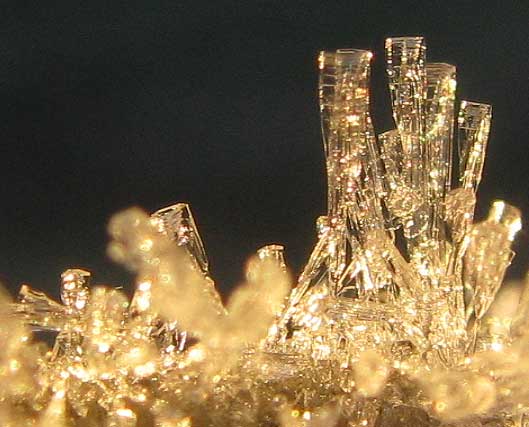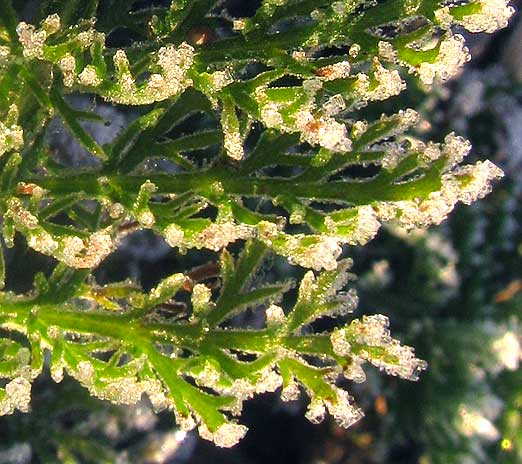Excerpts from Jim Conrad's
Naturalist Newsletter

from the January 13, 2013 Newsletter issued from the valley of the Dry Frio River in northern Uvalde County, southwestern Texas, on the southern border of the Edwards Plateau; elevation ~1750m (~5750 ft); N29.62°, W99.86°; USA
FROST CRYSTALS ON A FENCEPOST
On a frosty morning this week the rising sun produced such a sparkly landscape that I went out with the camera. A thick crust of ice topped my neighbor's concrete fencepost so, with the sun backlighting the frost, I photographed the frost, as you can see above.
When that image first appeared on my computer screen I was astonished to see that the crystals looked like long-stemmed wine glasses -- open bowls atop slender stems. Examining other images I decided that the crystals were cylindrical, not merely solid tubes of ice. You can see this yourself below:

In chemistry class we learned how the hydrogen and oxygen atoms of water, H20, combine into three-cornered molecules with a positive charge on one side of the lopsided molecule and a negative on the other. Then pairs of the bipolar water molecules align with one another, weakly held together by the negative and positive ends of each molecule in the pair being attracted to the opposite charges of their partner molecule. These pairs of three-cornered molecules form six-cornered, or hexagonal, latticeworks. Ice crystals begin with these simple hexagonal cores. That's why snowflakes have six arms. But this doesn't explain why our fencepost crystals look the way they do.
Browsing the Internet I learn that ice crystals grow by adding more and more hexagonal pairs of water molecules. Once a firm hexagonal prism is formed it branches out into more complicated patterns. Since the faces of a crystalline prism are smooth, it's difficult for new atoms to attach there. The corners are much easier to attach to, so crystals branch out from there. How the crystals grow depends on the temperature, how much water vapor is present to work with, air turbulence and other environmental features. Sometimes the prisms only grow from the top and the bottom, leading to long, thin columns. At other times, new hexagonal latticeworks develop at each corner of the prism, then they branch out providing new corners to branch from, and so on until very complicated patterns develop.
However, that still doesn't explain how cylindrical frost crystals might form.
Browsing more, I find that cylindrical ice crystals do exist but they don't look like ours. But I do stumble upon a page describing many kinds of snowflakes, where snowflakes called "hollow columns" at first glance may appear to be cylindrical but actually are solid, hexagonal tubes with shallow, cone-shaped depressions at their ends. You can see what "hollow columns" look like -- second line from the top -- on a CalTech Snowflake Identification Page. .
Assuming that the crystals in our photos are "hollow columns," why would they melt near their bases, converting the solid part of the column into the long-stemmed wine glass' slender stem, but not melt the top, hollow, cup part? Maybe it's simply because the fencepost was warmer than the surrounding air, so the part of the crystal closest to the post melted before the top part did.
These are just guesses, and I still don't know why cone-shaped depressions might form in a long, slender ice crystal. Whatever the deal, there's magic here merely in the fact that on a fencepost right beside the cabin such amazing crystals can form with no fanfare or particular reason
from the January 13, 2013 Newsletter issued from the valley of the Dry Frio River in northern Uvalde County, southwestern Texas, on the southern border of the Edwards Plateau; elevation ~1750m (~5750 ft); N29.62°, W99.86°; USA
FROST DAMAGE IN PLANTS
The frosty morning producing the crystals examined above sneaked up on me. The forecast had been for night temperatures well above freezing, so I'd left some plants out who got hurt.
The interesting thing was seeing that some plants were seriously damaged, while others didn't seem to suffer at all. For instance, two pots of different kinds of mint remained outside, both very similar vegetatively but smelling different. One mint suffered only minor damage but the other lost every leaf. Also, outside my door there's a colony of Yarrow with its overwintering green leaves forming rosettes that laced with frost looked very pretty. You can see a frost-covered Yarrow leaf below:

The Yarrows suffered no visible damage at all.
Studies show that it's not cold temperature that injures plants but rather ice formation inside and between the plant's cells. Ice crystals forming inside plant cells puncture cell membranes and generally disrupt the protoplasm's architecture and function. Damage caused by ice crystals between cells and forming on the plant's surface is thought to work by a more subtle mechanism.
There's a concept in thermodynamics referred to as "saturation vapor pressure," and it's too complicated to be dealt with here. Saturation vapor pressure is lower over ice than over liquid water, so when there's ice just outside a plant cell, water passes from inside the cell, through its semipermeable cell membranes, to gather on those ice crystals outside the cells -- as frost. This removal of water from inside the cells stresses the cells just as if they were suffering through a drought. In fact, drought-tolerant plants normally also display freeze tolerance.
By gradually exposing certain plant species to lower and lower temperatures over a period of nights, often the plants can be "hardened" to survive mild freezing. One way hardening works is that the gradually lowering temperatures cause an accumulation of sugars or sugar alcohols in the protoplasm, which lowers the protoplasm's freezing point. Other hardening mechanisms are known as well. Whatever the mechanism, though, typically a few days and nights without cold weather typically undo the hardening, and plants become vulnerable again.